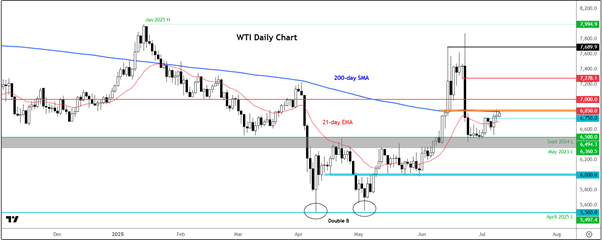prices have now risen in the past three days, although with waning momentum as macro concerns linger. But with oil trading at its highest levels in about two weeks, when there is so much bearish news out there, you might be wondering what has supported prices? After all, bearish speculators argue, there was a larger-than-expected OPEC+ increase for the month of August just at the weekend.
Despite this urgency to bring back more supplies online, oil prices have stopped falling further since that sharp de-escalation in the conflict between Israel and Iran a couple of weeks ago. What’s driving prices, and what’s in for the months ahead?
So Why Have Oil Prices Bounced Back?
One explanation behind the recent recovery in oil prices can be attributed to the fact that there were worries about demand owing to trade concerns hurting the global economy. Instead, trade fears have receded sharply, judging by the reaction in equity markets in the last couple of months (we saw benchmark stock indices surge from their April lows to hit record highs).
Granted, tariff uncertainty could flare up with Trump now saying he won’t extend deadlines beyond August 1 again. Meanwhile, inflation hasn’t picked up either, as had been feared due to the higher tariffs, and many central banks have been cutting rates in recent months.
At the same time, the US has passed a big budget and tax bill into law, which should boost economic output in the short term, all else being equal, even if it ultimately adds trillions to the national debt, which is probably not in the interest of the economy in the long term.
In the US, they are also nearing peak driving season when demand for gasoline surges. According to Reuters, citing travel industry statistics, a record number of Americans were set to travel for the Fourth of July holiday by road and air. Ahead of peak driving season, we have seen several sharp drawdowns in US oil stocks, pointing to strong demand.
Globally, the macro backdrop hasn’t been too great, but the fact that Saudi Arabia raised the August price for its flagship Arab Light crude to a four-month high for Asian customers at the weekend, this goes to shows that demand for oil remains strong there.
So, the crude oil has been supported in part because of receding fears about demand. But this alone won’t be enough to sustain higher prices. Supply is the main factor driving oil prices.
And What About Those OPEC+ Cuts?
The OPEC+ agreed to raise production by 548,000 barrels per day in August. This was more than the 411,000-bpd hikes they made for the earlier three months. As a result, the group has returned nearly half of the 2.2 million-bpd voluntary cuts from eight OPEC producers back into the market. Further production hikes are expected for September, which, according to Goldman Sachs, will amount to 550,000 bpd.
The key question is whether this was the right move and in the best interest of OPEC+. Clearly, the group doesn’t want to lose market share to non-OPEC producers. In fact, the US hasn’t been able to ramp up production meaningfully in recent months and therefore looks set to produce less oil in 2025 than previously expected.
That’s according to the Energy Information Administration, which forecasts the world’s largest oil producer to pump 13.37 million barrels per day of oil this year instead of last month’s forecast of 13.42 million bpd. In part, this due to the lower oil prices discouraging drilling activity.
Indeed, the number of oil and rigs have been plunging according to energy services firm Baker Hughes (NASDAQ:). The latest data from the company shows rig counts falling to 425 from around 780 rigs in 2022’s peak, marking a dramatic reversal and the lowest since October 2021.
It can be argued, therefore, that this might be the perfect opportunity for the OPEC+ to raise output as much as possible while the US drilling is not “drill-baby-drill”-ing.
Longer Term Outlook Remains Bearish
However, in the longer run, supply growth will need to be matched by equally strong demand growth to allow for sustainably higher prices. Given that Iran is now allowed to export more freely and the OPEC+ is ramping production, and Trump urging US producers to pump more oil, the long-term outlook remains bearish, which means the upside should be limited from here on, barring another supply-side shock.
WTI Technical Analysis and Levels to Watch
WTI has bounced back from the neckline of the double bottom pattern between $63.60 to $65.00 area (shaded in grey on the chart). This area remains crucial for long-term support, given that the lows of May 2023 and September 2024 were previously formed here, and now we are above it. Should WTI break back below this zone, the technical outlook would turn negative once again, which could encourage fresh selling below that zone.

One short-term support above this zone worth pointing out is now seen at $67.50, marking resistance from last week.
At the time of writing, WTI was now testing potential resistance in the $68.50 region. As well as former support, the 200-day moving average also comes into play here, making it a key battleground. Above this zone, the next potential resistance is the psychologically important handle of $70.00.
All told, WTI is bang in the middle of its range, which should keep both the bulls and bears interested. In this sort of trading environment, trading oil from level to level makes most sense to me, rather than applying a swing strategy.
***
Be sure to check out InvestingPro to stay in sync with the market trend and what it means for your trading. Whether you’re a novice investor or a seasoned trader, leveraging InvestingPro can unlock a world of investment opportunities while minimizing risks amid the challenging market backdrop.
- ProPicks AI: AI-selected stock winners with proven track record.
- InvestingPro Fair Value: Instantly find out if a stock is underpriced or overvalued.
- Advanced Stock Screener: Search for the best stocks based on hundreds of selected filters, and criteria.
- Top Ideas: See what stocks billionaire investors such as Warren Buffett, Michael Burry, and George Soros are buying.
Disclaimer: This article is written for informational purposes only; it does not constitute a solicitation, offer, advice, counsel or recommendation to invest as such it is not intended to incentivize the purchase of assets in any way. I would like to remind you that any type of asset, is evaluated from multiple perspectives and is highly risky and therefore, any investment decision and the associated risk remains with the investor.

